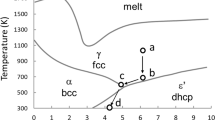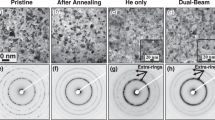Abstract
INTEREST in the stability of metal hydride materials has been stimulated by their potential use as reactor moderators and as target materials in neutron generating devices which could find widespread application in compact activation analysis equipment. Earlier work has scanned the thermal stability of most rare earth and yttrium dihydrides and dideuterides1–6, and the effects of varying the rare earth metal on the heats and entropies of formation have been discussed in terms of lattice energies and parameters2. The differences from one author to another are quite large in many instances; accordingly, when we decided to determine the thermal stability of a rare earth tritide a method involving measurements of the isotopic separation in a mixed deuterium–tritium system was preferred. Erbium metal was chosen as suitable in view of its cheapness and comparatively high oxidation resistance7. Titanium and uranium systems were also investigated, the former because of its common use in targets and the absence of good data on deuteride stability, and the latter because of the availability of dissociation pressure data for comparison.
This is a preview of subscription content, access via your institution
Access options
Subscribe to this journal
Receive 51 print issues and online access
$199.00 per year
only $3.90 per issue
Buy this article
- Purchase on Springer Link
- Instant access to full article PDF
Prices may be subject to local taxes which are calculated during checkout
Similar content being viewed by others
References
Jones, P. M. S., Southall, J., and Goodhead, K., AWRE Rep., 0–22/64 (1964).
Jones, P. M. S., Ellis, P., and Aslett, T., AWRE Rep., 0–31/66 (1966).
Warf, J. C., and Korst, W. L., USCL Rep. NP 6075 (1956).
Mulford, R. N. R., and Holley, C. E., J. Phys. Chem., 59, 1222 (1955).
Beck, R. L., Res. Rep. LAR 3 (1959) and LAR 10 (1960).
Sturdy, G. E., and Mulford, R. N. R., J. Amer. Chem. Soc., 78, 1083 (1956).
Jones, P. M. S., Goodhead, K., and Edmondson, W., AWRE Report 0–45/64 (1964).
Bigeleisen, J., and Kant, A., J. Amer. Chem. Soc., 76, 5957 (1954).
McQuillan, A. D., Proc. Roy. Soc., 204, 309 (1950).
Jones, P. M. S., Ellis, P., Smith, J. R., Aslett, T., and Hutchinson, C. G., AWRE Report 0–60/66 (1966).
Jones, P. M. S., Nature, 213, 689 (1967).
Jones, W. M., J. Chem. Phys., 17, 1062 (1949).
Flotow, H. E., and Abraham, B. M., AECD Report 3074 (1957).
Spedding, F. H., Nucleonics (January 4, 1949).
Author information
Authors and Affiliations
Rights and permissions
About this article
Cite this article
JONES, P., ELLIS, P. & ASLETT, T. Thermal Stability of Metal Hydrides, Deuterides and Tritides. Nature 223, 829–830 (1969). https://doi.org/10.1038/223829b0
Received:
Issue Date:
DOI: https://doi.org/10.1038/223829b0
This article is cited by
-
The growth of crystals of erbium hydride
Journal of Materials Science (1981)
-
Economic considerations relevant to the development of new materials
Journal of Materials Science (1970)
Comments
By submitting a comment you agree to abide by our Terms and Community Guidelines. If you find something abusive or that does not comply with our terms or guidelines please flag it as inappropriate.



